Ryan McKenna
Correlated Noise Mechanisms for Differentially Private Learning
Jun 09, 2025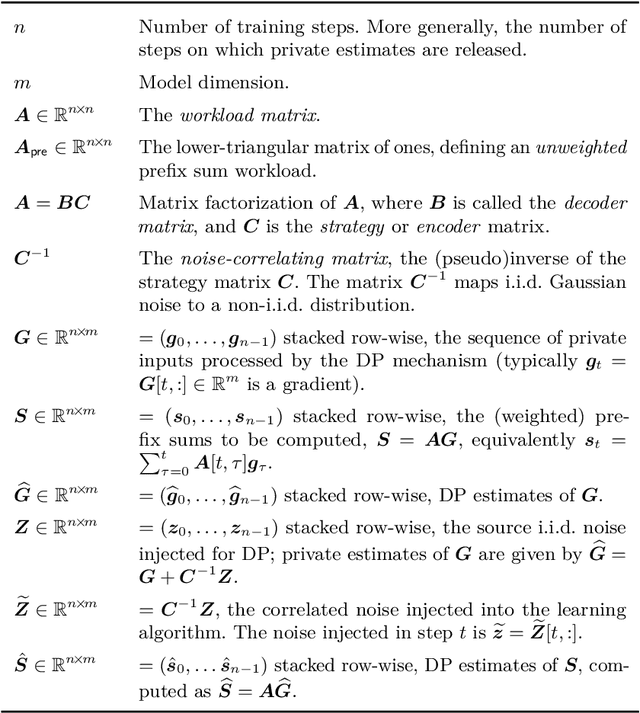

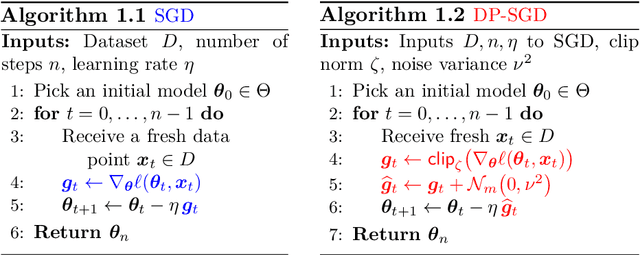

Abstract:This monograph explores the design and analysis of correlated noise mechanisms for differential privacy (DP), focusing on their application to private training of AI and machine learning models via the core primitive of estimation of weighted prefix sums. While typical DP mechanisms inject independent noise into each step of a stochastic gradient (SGD) learning algorithm in order to protect the privacy of the training data, a growing body of recent research demonstrates that introducing (anti-)correlations in the noise can significantly improve privacy-utility trade-offs by carefully canceling out some of the noise added on earlier steps in subsequent steps. Such correlated noise mechanisms, known variously as matrix mechanisms, factorization mechanisms, and DP-Follow-the-Regularized-Leader (DP-FTRL) when applied to learning algorithms, have also been influential in practice, with industrial deployment at a global scale.
Back to Square Roots: An Optimal Bound on the Matrix Factorization Error for Multi-Epoch Differentially Private SGD
May 17, 2025Abstract:Matrix factorization mechanisms for differentially private training have emerged as a promising approach to improve model utility under privacy constraints. In practical settings, models are typically trained over multiple epochs, requiring matrix factorizations that account for repeated participation. Existing theoretical upper and lower bounds on multi-epoch factorization error leave a significant gap. In this work, we introduce a new explicit factorization method, Banded Inverse Square Root (BISR), which imposes a banded structure on the inverse correlation matrix. This factorization enables us to derive an explicit and tight characterization of the multi-epoch error. We further prove that BISR achieves asymptotically optimal error by matching the upper and lower bounds. Empirically, BISR performs on par with state-of-the-art factorization methods, while being simpler to implement, computationally efficient, and easier to analyze.
It's My Data Too: Private ML for Datasets with Multi-User Training Examples
Mar 05, 2025

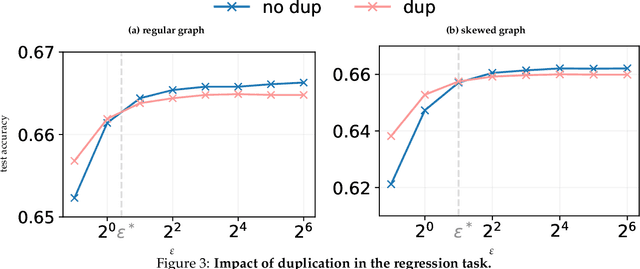
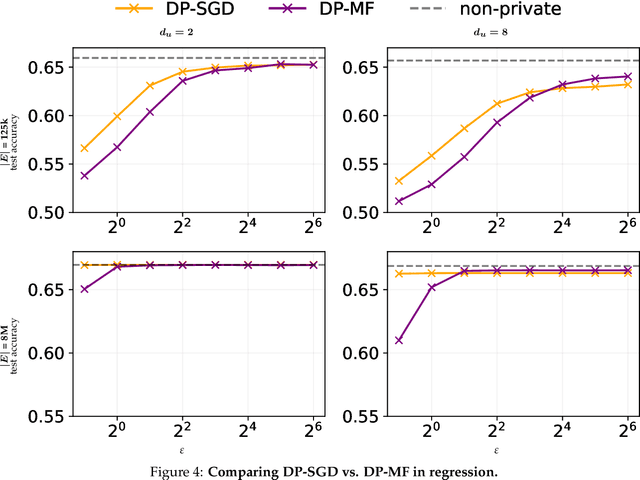
Abstract:We initiate a study of algorithms for model training with user-level differential privacy (DP), where each example may be attributed to multiple users, which we call the multi-attribution model. We first provide a carefully chosen definition of user-level DP under the multi-attribution model. Training in the multi-attribution model is facilitated by solving the contribution bounding problem, i.e. the problem of selecting a subset of the dataset for which each user is associated with a limited number of examples. We propose a greedy baseline algorithm for the contribution bounding problem. We then empirically study this algorithm for a synthetic logistic regression task and a transformer training task, including studying variants of this baseline algorithm that optimize the subset chosen using different techniques and criteria. We find that the baseline algorithm remains competitive with its variants in most settings, and build a better understanding of the practical importance of a bias-variance tradeoff inherent in solutions to the contribution bounding problem.
Is API Access to LLMs Useful for Generating Private Synthetic Tabular Data?
Feb 10, 2025

Abstract:Differentially private (DP) synthetic data is a versatile tool for enabling the analysis of private data. Recent advancements in large language models (LLMs) have inspired a number of algorithm techniques for improving DP synthetic data generation. One family of approaches uses DP finetuning on the foundation model weights; however, the model weights for state-of-the-art models may not be public. In this work we propose two DP synthetic tabular data algorithms that only require API access to the foundation model. We adapt the Private Evolution algorithm (Lin et al., 2023; Xie et al., 2024) -- which was designed for image and text data -- to the tabular data domain. In our extension of Private Evolution, we define a query workload-based distance measure, which may be of independent interest. We propose a family of algorithms that use one-shot API access to LLMs, rather than adaptive queries to the LLM. Our findings reveal that API-access to powerful LLMs does not always improve the quality of DP synthetic data compared to established baselines that operate without such access. We provide insights into the underlying reasons and propose improvements to LLMs that could make them more effective for this application.
Scaling Laws for Differentially Private Language Models
Jan 31, 2025Abstract:Scaling laws have emerged as important components of large language model (LLM) training as they can predict performance gains through scale, and provide guidance on important hyper-parameter choices that would otherwise be expensive. LLMs also rely on large, high-quality training datasets, like those sourced from (sometimes sensitive) user data. Training models on this sensitive user data requires careful privacy protections like differential privacy (DP). However, the dynamics of DP training are significantly different, and consequently their scaling laws are not yet fully understood. In this work, we establish scaling laws that accurately model the intricacies of DP LLM training, providing a complete picture of the compute-privacy-utility tradeoffs and the optimal training configurations in many settings.
Fine-Tuning Large Language Models with User-Level Differential Privacy
Jul 10, 2024Abstract:We investigate practical and scalable algorithms for training large language models (LLMs) with user-level differential privacy (DP) in order to provably safeguard all the examples contributed by each user. We study two variants of DP-SGD with: (1) example-level sampling (ELS) and per-example gradient clipping, and (2) user-level sampling (ULS) and per-user gradient clipping. We derive a novel user-level DP accountant that allows us to compute provably tight privacy guarantees for ELS. Using this, we show that while ELS can outperform ULS in specific settings, ULS generally yields better results when each user has a diverse collection of examples. We validate our findings through experiments in synthetic mean estimation and LLM fine-tuning tasks under fixed compute budgets. We find that ULS is significantly better in settings where either (1) strong privacy guarantees are required, or (2) the compute budget is large. Notably, our focus on LLM-compatible training algorithms allows us to scale to models with hundreds of millions of parameters and datasets with hundreds of thousands of users.
Scaling up the Banded Matrix Factorization Mechanism for Differentially Private ML
May 24, 2024
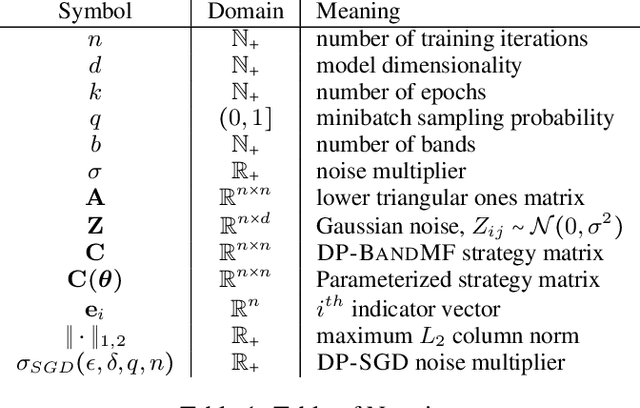
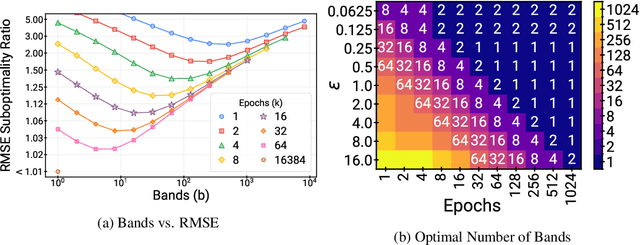
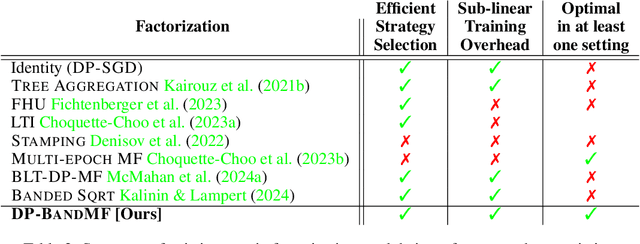
Abstract:DP-BandMF offers a powerful approach to differentially private machine learning, balancing privacy amplification with noise correlation for optimal noise reduction. However, its scalability has been limited to settings where the number of training iterations is less than $10^4$. In this work, we present techniques that significantly extend DP-BandMF's reach, enabling use in settings with and over $10^6$ training iterations. Our enhanced implementation, coupled with extensive experiments, provides clear guidelines on selecting the optimal number of bands. These insights offer practitioners a deeper understanding of DP-BandMF's performance and how to maximize its utility for privacy-preserving machine learning.
Joint Selection: Adaptively Incorporating Public Information for Private Synthetic Data
Mar 12, 2024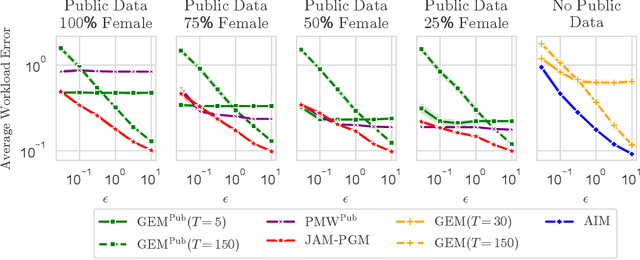

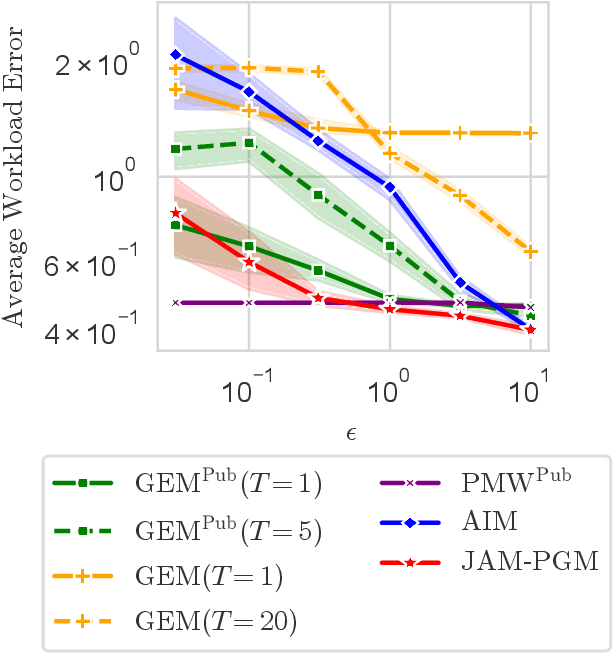
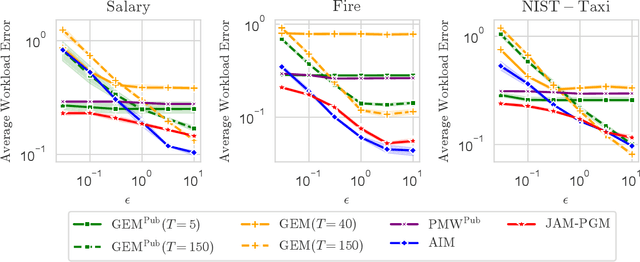
Abstract:Mechanisms for generating differentially private synthetic data based on marginals and graphical models have been successful in a wide range of settings. However, one limitation of these methods is their inability to incorporate public data. Initializing a data generating model by pre-training on public data has shown to improve the quality of synthetic data, but this technique is not applicable when model structure is not determined a priori. We develop the mechanism jam-pgm, which expands the adaptive measurements framework to jointly select between measuring public data and private data. This technique allows for public data to be included in a graphical-model-based mechanism. We show that jam-pgm is able to outperform both publicly assisted and non publicly assisted synthetic data generation mechanisms even when the public data distribution is biased.
(Amplified) Banded Matrix Factorization: A unified approach to private training
Jun 13, 2023



Abstract:Matrix factorization (MF) mechanisms for differential privacy (DP) have substantially improved the state-of-the-art in privacy-utility-computation tradeoffs for ML applications in a variety of scenarios, but in both the centralized and federated settings there remain instances where either MF cannot be easily applied, or other algorithms provide better tradeoffs (typically, as $\epsilon$ becomes small). In this work, we show how MF can subsume prior state-of-the-art algorithms in both federated and centralized training settings, across all privacy budgets. The key technique throughout is the construction of MF mechanisms with banded matrices. For cross-device federated learning (FL), this enables multiple-participations with a relaxed device participation schema compatible with practical FL infrastructure (as demonstrated by a production deployment). In the centralized setting, we prove that banded matrices enjoy the same privacy amplification results as for the ubiquitous DP-SGD algorithm, but can provide strictly better performance in most scenarios -- this lets us always at least match DP-SGD, and often outperform it even at $\epsilon\ll2$. Finally, $\hat{b}$-banded matrices substantially reduce the memory and time complexity of per-step noise generation from $\mathcal{O}(n)$, $n$ the total number of iterations, to a constant $\mathcal{O}(\hat{b})$, compared to general MF mechanisms.
Convergence of Gradient Descent with Linearly Correlated Noise and Applications to Differentially Private Learning
Feb 02, 2023



Abstract:We study stochastic optimization with linearly correlated noise. Our study is motivated by recent methods for optimization with differential privacy (DP), such as DP-FTRL, which inject noise via matrix factorization mechanisms. We propose an optimization problem that distils key facets of these DP methods and that involves perturbing gradients by linearly correlated noise. We derive improved convergence rates for gradient descent in this framework for convex and non-convex loss functions. Our theoretical analysis is novel and might be of independent interest. We use these convergence rates to develop new, effective matrix factorizations for differentially private optimization, and highlight the benefits of these factorizations theoretically and empirically.
 Add to Chrome
Add to Chrome Add to Firefox
Add to Firefox Add to Edge
Add to Edge